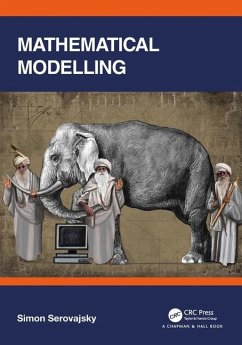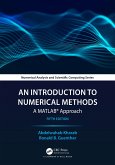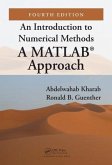Simon Serovajsky
Mathematical Modelling
Simon Serovajsky
Mathematical Modelling
- Broschiertes Buch
- Merkliste
- Auf die Merkliste
- Bewerten Bewerten
- Teilen
- Produkt teilen
- Produkterinnerung
- Produkterinnerung
Mathematical Modelling sets out the general principles of mathematical modelling as a means comprehending the world. Within the book, the problems of physics, engineering, chemistry, biology, medicine, economics, ecology, sociology, psychology, political science, etc. are all considered through this uniform lens.
The author describes different classes of models, including lumped and distributed parameter systems, deterministic and stochastic models, continuous and discrete models, static and dynamical systems, and more. From a mathematical point of view, the considered models can be…mehr
Andere Kunden interessierten sich auch für
![Modeling Change and Uncertainty Modeling Change and Uncertainty]() William P. FoxModeling Change and Uncertainty90,99 €
William P. FoxModeling Change and Uncertainty90,99 €![Introduction to Mathematical Modeling Introduction to Mathematical Modeling]() Mayer HumiIntroduction to Mathematical Modeling49,99 €
Mayer HumiIntroduction to Mathematical Modeling49,99 €![An Introduction to Numerical Methods An Introduction to Numerical Methods]() Abdelwahab KharabAn Introduction to Numerical Methods63,99 €
Abdelwahab KharabAn Introduction to Numerical Methods63,99 €![Modelling with Ordinary Differential Equations Modelling with Ordinary Differential Equations]() Alfio BorzìModelling with Ordinary Differential Equations49,99 €
Alfio BorzìModelling with Ordinary Differential Equations49,99 €![An Introduction to Numerical Methods An Introduction to Numerical Methods]() Abdelwahab KharabAn Introduction to Numerical Methods107,99 €
Abdelwahab KharabAn Introduction to Numerical Methods107,99 €![Introduction to Traveling Waves Introduction to Traveling Waves]() Anna R. GhazaryanIntroduction to Traveling Waves99,99 €
Anna R. GhazaryanIntroduction to Traveling Waves99,99 €![A Concise Introduction to Geometric Numerical Integration A Concise Introduction to Geometric Numerical Integration]() Sergio BlanesA Concise Introduction to Geometric Numerical Integration173,99 €
Sergio BlanesA Concise Introduction to Geometric Numerical Integration173,99 €-
-
-
Mathematical Modelling sets out the general principles of mathematical modelling as a means comprehending the world. Within the book, the problems of physics, engineering, chemistry, biology, medicine, economics, ecology, sociology, psychology, political science, etc. are all considered through this uniform lens.
The author describes different classes of models, including lumped and distributed parameter systems, deterministic and stochastic models, continuous and discrete models, static and dynamical systems, and more. From a mathematical point of view, the considered models can be understood as equations and systems of equations of different nature and variational principles. In addition to this, mathematical features of mathematical models, applied control and optimization problems based on mathematical models, and identification of mathematical models are also presented.
Features
Each chapter includes four levels: a lecture (main chaptermaterial), an appendix (additional information), notes (explanations, technical calculations, literature review) and tasks for independent work; this is suitable for undergraduates and graduate students and does not require the reader to take any prerequisite course, but may be useful for researchers as well
Described mathematical models are grouped both by areas of application and by the types of obtained mathematical problems, which contributes to both the breadth of coverage of the material and the depth of its understanding
Can be used as the main textbook on a mathematical modelling course, and is also recommended for special courses on mathematical models for physics, chemistry, biology, economics, etc.
The author describes different classes of models, including lumped and distributed parameter systems, deterministic and stochastic models, continuous and discrete models, static and dynamical systems, and more. From a mathematical point of view, the considered models can be understood as equations and systems of equations of different nature and variational principles. In addition to this, mathematical features of mathematical models, applied control and optimization problems based on mathematical models, and identification of mathematical models are also presented.
Features
Each chapter includes four levels: a lecture (main chaptermaterial), an appendix (additional information), notes (explanations, technical calculations, literature review) and tasks for independent work; this is suitable for undergraduates and graduate students and does not require the reader to take any prerequisite course, but may be useful for researchers as well
Described mathematical models are grouped both by areas of application and by the types of obtained mathematical problems, which contributes to both the breadth of coverage of the material and the depth of its understanding
Can be used as the main textbook on a mathematical modelling course, and is also recommended for special courses on mathematical models for physics, chemistry, biology, economics, etc.
Produktdetails
- Produktdetails
- Verlag: Chapman and Hall/CRC / Taylor & Francis
- Seitenzahl: 466
- Erscheinungstermin: 29. Januar 2024
- Englisch
- Abmessung: 254mm x 178mm x 25mm
- Gewicht: 784g
- ISBN-13: 9781032147871
- ISBN-10: 1032147873
- Artikelnr.: 69923641
- Herstellerkennzeichnung
- Libri GmbH
- Europaallee 1
- 36244 Bad Hersfeld
- gpsr@libri.de
- Verlag: Chapman and Hall/CRC / Taylor & Francis
- Seitenzahl: 466
- Erscheinungstermin: 29. Januar 2024
- Englisch
- Abmessung: 254mm x 178mm x 25mm
- Gewicht: 784g
- ISBN-13: 9781032147871
- ISBN-10: 1032147873
- Artikelnr.: 69923641
- Herstellerkennzeichnung
- Libri GmbH
- Europaallee 1
- 36244 Bad Hersfeld
- gpsr@libri.de
Simon Serovajsky is a professor of mathematics at al-Farabi Kazakh National University in Kazakhstan. He is the author of many books published in the area of optimization and optimal control theory, mathematical physics, mathematical modelling, philosophy and history of mathematics as well as a long list of high-quality publications in learned journals.
Foundations of mathematical modelling. Lecture. 1.1 Cognition and modelling. 1.2 Natural sciences and Mathematics. 1.3 Content or form? 1.4 Copernicus or Ptolemy? 1.5 Mathematical model of a body falling. 1.6 Principles of mathematical model determining. 1.7. Classification of mathematical models. Appendix. 1. Probe movement. 2. Missile flight. 3 Glider flight. Notes. I. Systems with lumped parameters. 2. Approximate solving of differential equations. Lecture. 2.1 Conception of approximate solution. 2.2 Euler method. 2.3 Probe movement. 2.4 Missile flight. 2.5. Glider flight. Appendix. 1. Runge-Kutta method. 2. Two-body problem. 3. Predator-pray model. Notes. 3. Mechanical Oscillations. Lecture. 3.1. Determination of the pendulum oscillation equation. 3.2 Solving of the pendulum oscillation equation. 3.3 Pendulum oscillation energy. 3.4 Oscillation of a pendulum with friction. 3.5 Equilibrium position of the pendulum. 3.6 Forced oscillations of the pendulum. Appendix. 1. Spring oscillation. 2. Large pendulum oscillations. 3. Problems of nonlinear oscillation theory. Notes. 4 Electrical Oscillations. Lecture. 4.1 Electrical circuit. 4.2 Energy of circuit. 4.3 Circuit with resistance. 4.4 Forced circuit oscillations. Appendix. 1. Forced oscillations of spring. 2. Circuit with nonlinear capacity. 3 Van der Pol circuit. Notes. 5. Elements of dynamical system theory. Lecture. 5.1. Evolutionary processes and differential equations. 5.2 General notions of dynamic systems theory. 5.3 Change in species number with excess food. 5.4 Oscillations of pendulum. 5.5 Stability of the equilibrium position. 5.6 Limit cycle. Appendix. 1. Exponential growth systems. 2. Brussellator. 3. System with two limit cycle. Notes. 6. Mathematical models in chemistry. Lecture. 6.1. Chemical kinetics equations. 6.2. Monomolecular reaction. 6.3. Bimolecular reaction. 6.4. Lotka reaction system. Appendix. 1. Brusselator. 2. Oregonator. 3. Chemical niche. 4. Laser healing model. Notes. 7. Mathematical model in biology. Lecture. 7.1. One species evolution. 7.2. Biological competition model. 7.3 Predator-prey model. 7.4 Symbiosis model. Appendix. 1. Models of chemical and physical competition. 2. Fluctuations in yield and fertility. 3. Ecological niche model. 4. SIR model for spread of disease. 5. Antibiotic resistance model. Notes. 8. Mathematical model of economics. Lecture. 1. One company evolution. 2. Economic competition model. 3. Economic niche model. 4. Free market model. 5. Monopolized market model. Appendix. 1. Ecological niche model. 2. Inflation model. 3. Model of economic cooperation. 4. Racketeer - entrepreneur model. 5. Solow model of economic growth. Notes. 9. Mathematical models in social sciences. Lecture. 9.1. Political competition. 9.2. Political niche. 9.3. Bipartisan system. 9.4. Trade union activity. 9.5 Allied relations. Appendix. 1. Competition models. 2. Niche models. 3. Predator-prey models. Notes. II. Systems with distributed parameters. 10. Mathematical models of transfer processes. Lecture. 10.1 Heat equation. 10.2 First boundary value problem for the homogeneous heat equation. 10.3 Non-homogeneous heat equation. Appendix. 1. Generalizations of the heat equation. 2. Second boundary value problem for the heat equation. 3. Diffusion equation. Notes. 11. Mathematical models of transfer processes. Lecture. 1. Heat equation and similarity theory. 2. Goods transfer equation. 3. Finite difference method for the heat equation. 4. Diffusion of chemical reactants. 5. Stefan problem for the heat equation. Appendix. 1. Overview of transfer processes. 2. Finite difference method. Implicit scheme. 3. Competitive species migration. 4. Hormone treatment of the tumor with hormone resistance. Notes. 12. Wave processes. Lecture. 12.1. Vibration of string. 12.2. Vibrations of string with fixed ends. 12.3 Infinitely long string. 12.4. Electrical vibrations in wires. Appendix. 1. Energy of vibrating string. 2. Mathematical models of wave processes. 3. Beam vibrations. 4. Maxwell equations. 5. Finite difference method for the vibrating string equation. Notes. 13. Mathematical models of stationary systems. Lecture. 13.1. Stationary heat transfer 13.2. Spherical and cylindrical coordinates. 13.3 Vector fields. 13.4. Electrostatic field. 13.5 Gravity field. Appendix. 1. Stationary fluid flow. 2. Steady oscillations. 3. Bending a thin elastic plate. 4. Variable separation method for the Laplace equation in a circle. 5. Establishment method. Notes. 14. Mathematical models of fluid and gas mechanics. Lecture. 14.1. Vibration string equation. 14.2. Ideal fluid movement. 14.3. Ideal fluid under the gravity field. 14.4. Viscous fluid movement. Appendix. 1. Burgers equation. 2. Surface wave movement. 3. Boundary layer model. 4. Acoustic problem. 5. Thermal convection. 6. Problems of magnetohydrodynamics. Notes. 15. Mathematical models of quantum mechanical systems. Lecture. 15.1. Quantum mechanics problems. 15.2. Wave function. 15.3. Schrödinger equation. 15.4. Particle movement under an external field. 15.5. Potential barrier. Appendix. 1. Wave function normalization. 2. Particle movement in a well with infinitely high walls. Notes. III. Other mathematical models. 16. Variational principles. Lecture. 1. Brachistochrone problem. 2. Lagrange problem. 3. Shortest curve. 4. Body falling problem and the concept of action. 5. Principle of least action. 6. Vibrations of string. Appendix. 1. Law of conservation of energy. 2. Fermat's principle and light refraction. 3. River crossing problem. 4. Pendulum oscillations. 5. Approximate solution of minimization problems. Notes. 17. Discrete models. Lecture. 17.1. Discrete population dynamics models. 17.2. Discrete heat transfer model. 17.3. Transportation problem. 17.4. Traveling salesman problem. 17.5. Prisoner's Dilemma. Appendix. 1. Discrete model of epidemic propagation. 2. Potential method for solving a transportation problem. 3. Production planning. 4. Concepts of game theory. Notes. 18. Stochastic models. Lecture. 18.1. Stochastic model of pure birth. 18.2. Monte Carlo method. 18.3. Stochastic model of population death. 18.4. Stochastic Malthus model. Appendix. 1. Malthus model with random population growth. 2. Models with random parameters. 3. Discrete model of selling goods. 4. Passage of a neutron through a plate. Notes. IV. Additions. 19. Mathematical problems of mathematical models. Lecture. 19.1. Cauchy problem properties for differential equations. 19.2. Properties of boundary value problems. 19.3. Boundary value problems for the heat equation. 19.4. Hadamard's example and well-posedness of problems. 19.5. Classical and generalized solution of problems. Appendix. 1. Nonlinear boundary value problems. 2. Euler's elastic problem. 3. Bénard problem. 4. Generalized model of stationary heat transfer. 5. Sequential model of stationary heat transfer. Notes. 20. Optimal control problems. Lecture. 20.1. Maximizing the shell fight range. 20.2. Maximizing the missile fight range. 20.3. General optimal control problem. 20.4. Solving of the maximization problem of the missile fight range. 20.5. Time-optimal control problem. Appendix. 1. Maximizing the probe's ascent height. 2. Approximate methods for solving optimality conditions. 3. Gradient methods. Notes. 21. Identification of mathematical models. Lecture. 21.1. Problem of determining the system parameters. 21.2. Inverse problems and their solving. 21.3. Heat equation with data at the final time. 21.4. Differentiation of functionals and gradient methods. 21.5. Solving of the heat equation with reversed time. Appendix. 1. Boundary inverse problem for the heat equation. 2. Inverse problem for the falling of body. 3. Inverse gravimetry problem. 4. Well-posedness of optimal control problems. Notes. Epilogue. Bibliography. Index.
Foundations of mathematical modelling. Lecture. 1.1 Cognition and
modelling. 1.2 Natural sciences and Mathematics. 1.3 Content or form? 1.4
Copernicus or Ptolemy? 1.5 Mathematical model of a body falling. 1.6
Principles of mathematical model determining. 1.7. Classification of
mathematical models. Appendix. 1. Probe movement. 2. Missile flight. 3
Glider flight. Notes. I. Systems with lumped parameters. 2. Approximate
solving of differential equations. Lecture. 2.1 Conception of approximate
solution. 2.2 Euler method. 2.3 Probe movement. 2.4 Missile flight. 2.5.
Glider flight. Appendix. 1. Runge-Kutta method. 2. Two-body problem. 3.
Predator-pray model. Notes. 3. Mechanical Oscillations. Lecture. 3.1.
Determination of the pendulum oscillation equation. 3.2 Solving of the
pendulum oscillation equation. 3.3 Pendulum oscillation energy. 3.4
Oscillation of a pendulum with friction. 3.5 Equilibrium position of the
pendulum. 3.6 Forced oscillations of the pendulum. Appendix. 1. Spring
oscillation. 2. Large pendulum oscillations. 3. Problems of nonlinear
oscillation theory. Notes. 4 Electrical Oscillations. Lecture. 4.1
Electrical circuit. 4.2 Energy of circuit. 4.3 Circuit with resistance. 4.4
Forced circuit oscillations. Appendix. 1. Forced oscillations of spring. 2.
Circuit with nonlinear capacity. 3 Van der Pol circuit. Notes. 5. Elements
of dynamical system theory. Lecture. 5.1. Evolutionary processes and
differential equations. 5.2 General notions of dynamic systems theory. 5.3
Change in species number with excess food. 5.4 Oscillations of pendulum.
5.5 Stability of the equilibrium position. 5.6 Limit cycle. Appendix. 1.
Exponential growth systems. 2. Brussellator. 3. System with two limit
cycle. Notes. 6. Mathematical models in chemistry. Lecture. 6.1. Chemical
kinetics equations. 6.2. Monomolecular reaction. 6.3. Bimolecular reaction.
6.4. Lotka reaction system. Appendix. 1. Brusselator. 2. Oregonator. 3.
Chemical niche. 4. Laser healing model. Notes. 7. Mathematical model in
biology. Lecture. 7.1. One species evolution. 7.2. Biological competition
model. 7.3 Predator-prey model. 7.4 Symbiosis model. Appendix. 1. Models of
chemical and physical competition. 2. Fluctuations in yield and fertility.
3. Ecological niche model. 4. SIR model for spread of disease. 5.
Antibiotic resistance model. Notes. 8. Mathematical model of economics.
Lecture. 1. One company evolution. 2. Economic competition model. 3.
Economic niche model. 4. Free market model. 5. Monopolized market model.
Appendix. 1. Ecological niche model. 2. Inflation model. 3. Model of
economic cooperation. 4. Racketeer - entrepreneur model. 5. Solow model of
economic growth. Notes. 9. Mathematical models in social sciences.
Lecture. 9.1. Political competition. 9.2. Political niche. 9.3. Bipartisan
system. 9.4. Trade union activity. 9.5 Allied relations. Appendix. 1.
Competition models. 2. Niche models. 3. Predator-prey models. Notes. II.
Systems with distributed parameters. 10. Mathematical models of transfer
processes. Lecture. 10.1 Heat equation. 10.2 First boundary value problem
for the homogeneous heat equation. 10.3 Non-homogeneous heat equation.
Appendix. 1. Generalizations of the heat equation. 2. Second boundary value
problem for the heat equation. 3. Diffusion equation. Notes. 11.
Mathematical models of transfer processes. Lecture. 1. Heat equation and
similarity theory. 2. Goods transfer equation. 3. Finite difference method
for the heat equation. 4. Diffusion of chemical reactants. 5. Stefan
problem for the heat equation. Appendix. 1. Overview of transfer processes.
2. Finite difference method. Implicit scheme. 3. Competitive species
migration. 4. Hormone treatment of the tumor with hormone resistance.
Notes. 12. Wave processes. Lecture. 12.1. Vibration of string. 12.2.
Vibrations of string with fixed ends. 12.3 Infinitely long string. 12.4.
Electrical vibrations in wires. Appendix. 1. Energy of vibrating string. 2.
Mathematical models of wave processes. 3. Beam vibrations. 4. Maxwell
equations. 5. Finite difference method for the vibrating string equation.
Notes. 13. Mathematical models of stationary systems. Lecture. 13.1.
Stationary heat transfer 13.2. Spherical and cylindrical coordinates. 13.3
Vector fields. 13.4. Electrostatic field. 13.5 Gravity field. Appendix. 1.
Stationary fluid flow. 2. Steady oscillations. 3. Bending a thin elastic
plate. 4. Variable separation method for the Laplace equation in a circle.
5. Establishment method. Notes. 14. Mathematical models of fluid and gas
mechanics. Lecture. 14.1. Vibration string equation. 14.2. Ideal fluid
movement. 14.3. Ideal fluid under the gravity field. 14.4. Viscous fluid
movement. Appendix. 1. Burgers equation. 2. Surface wave movement. 3.
Boundary layer model. 4. Acoustic problem. 5. Thermal convection. 6.
Problems of magnetohydrodynamics. Notes. 15. Mathematical models of quantum
mechanical systems. Lecture. 15.1. Quantum mechanics problems. 15.2. Wave
function. 15.3. Schrödinger equation. 15.4. Particle movement under an
external field. 15.5. Potential barrier. Appendix. 1. Wave function
normalization. 2. Particle movement in a well with infinitely high walls.
Notes. III. Other mathematical models. 16. Variational principles.
Lecture. 1. Brachistochrone problem. 2. Lagrange problem. 3. Shortest
curve. 4. Body falling problem and the concept of action. 5. Principle of
least action. 6. Vibrations of string. Appendix. 1. Law of conservation of
energy. 2. Fermat's principle and light refraction. 3. River crossing
problem. 4. Pendulum oscillations. 5. Approximate solution of minimization
problems. Notes. 17. Discrete models. Lecture. 17.1. Discrete population
dynamics models. 17.2. Discrete heat transfer model. 17.3. Transportation
problem. 17.4. Traveling salesman problem. 17.5. Prisoner's Dilemma.
Appendix. 1. Discrete model of epidemic propagation. 2. Potential method
for solving a transportation problem. 3. Production planning. 4. Concepts
of game theory. Notes. 18. Stochastic models. Lecture. 18.1. Stochastic
model of pure birth. 18.2. Monte Carlo method. 18.3. Stochastic model of
population death. 18.4. Stochastic Malthus model. Appendix. 1. Malthus
model with random population growth. 2. Models with random parameters. 3.
Discrete model of selling goods. 4. Passage of a neutron through a plate.
Notes. IV. Additions. 19. Mathematical problems of mathematical models.
Lecture. 19.1. Cauchy problem properties for differential equations. 19.2.
Properties of boundary value problems. 19.3. Boundary value problems for
the heat equation. 19.4. Hadamard's example and well-posedness of problems.
19.5. Classical and generalized solution of problems. Appendix. 1.
Nonlinear boundary value problems. 2. Euler's elastic problem. 3. Bénard
problem. 4. Generalized model of stationary heat transfer. 5. Sequential
model of stationary heat transfer. Notes. 20. Optimal control problems.
Lecture. 20.1. Maximizing the shell fight range. 20.2. Maximizing the
missile fight range. 20.3. General optimal control problem. 20.4. Solving
of the maximization problem of the missile fight range. 20.5. Time-optimal
control problem. Appendix. 1. Maximizing the probe's ascent height. 2.
Approximate methods for solving optimality conditions. 3. Gradient methods.
Notes. 21. Identification of mathematical models. Lecture. 21.1. Problem of
determining the system parameters. 21.2. Inverse problems and their
solving. 21.3. Heat equation with data at the final time. 21.4.
Differentiation of functionals and gradient methods. 21.5. Solving of the
heat equation with reversed time. Appendix. 1. Boundary inverse problem for
the heat equation. 2. Inverse problem for the falling of body. 3. Inverse
gravimetry problem. 4. Well-posedness of optimal control problems. Notes.
Epilogue. Bibliography. Index.
modelling. 1.2 Natural sciences and Mathematics. 1.3 Content or form? 1.4
Copernicus or Ptolemy? 1.5 Mathematical model of a body falling. 1.6
Principles of mathematical model determining. 1.7. Classification of
mathematical models. Appendix. 1. Probe movement. 2. Missile flight. 3
Glider flight. Notes. I. Systems with lumped parameters. 2. Approximate
solving of differential equations. Lecture. 2.1 Conception of approximate
solution. 2.2 Euler method. 2.3 Probe movement. 2.4 Missile flight. 2.5.
Glider flight. Appendix. 1. Runge-Kutta method. 2. Two-body problem. 3.
Predator-pray model. Notes. 3. Mechanical Oscillations. Lecture. 3.1.
Determination of the pendulum oscillation equation. 3.2 Solving of the
pendulum oscillation equation. 3.3 Pendulum oscillation energy. 3.4
Oscillation of a pendulum with friction. 3.5 Equilibrium position of the
pendulum. 3.6 Forced oscillations of the pendulum. Appendix. 1. Spring
oscillation. 2. Large pendulum oscillations. 3. Problems of nonlinear
oscillation theory. Notes. 4 Electrical Oscillations. Lecture. 4.1
Electrical circuit. 4.2 Energy of circuit. 4.3 Circuit with resistance. 4.4
Forced circuit oscillations. Appendix. 1. Forced oscillations of spring. 2.
Circuit with nonlinear capacity. 3 Van der Pol circuit. Notes. 5. Elements
of dynamical system theory. Lecture. 5.1. Evolutionary processes and
differential equations. 5.2 General notions of dynamic systems theory. 5.3
Change in species number with excess food. 5.4 Oscillations of pendulum.
5.5 Stability of the equilibrium position. 5.6 Limit cycle. Appendix. 1.
Exponential growth systems. 2. Brussellator. 3. System with two limit
cycle. Notes. 6. Mathematical models in chemistry. Lecture. 6.1. Chemical
kinetics equations. 6.2. Monomolecular reaction. 6.3. Bimolecular reaction.
6.4. Lotka reaction system. Appendix. 1. Brusselator. 2. Oregonator. 3.
Chemical niche. 4. Laser healing model. Notes. 7. Mathematical model in
biology. Lecture. 7.1. One species evolution. 7.2. Biological competition
model. 7.3 Predator-prey model. 7.4 Symbiosis model. Appendix. 1. Models of
chemical and physical competition. 2. Fluctuations in yield and fertility.
3. Ecological niche model. 4. SIR model for spread of disease. 5.
Antibiotic resistance model. Notes. 8. Mathematical model of economics.
Lecture. 1. One company evolution. 2. Economic competition model. 3.
Economic niche model. 4. Free market model. 5. Monopolized market model.
Appendix. 1. Ecological niche model. 2. Inflation model. 3. Model of
economic cooperation. 4. Racketeer - entrepreneur model. 5. Solow model of
economic growth. Notes. 9. Mathematical models in social sciences.
Lecture. 9.1. Political competition. 9.2. Political niche. 9.3. Bipartisan
system. 9.4. Trade union activity. 9.5 Allied relations. Appendix. 1.
Competition models. 2. Niche models. 3. Predator-prey models. Notes. II.
Systems with distributed parameters. 10. Mathematical models of transfer
processes. Lecture. 10.1 Heat equation. 10.2 First boundary value problem
for the homogeneous heat equation. 10.3 Non-homogeneous heat equation.
Appendix. 1. Generalizations of the heat equation. 2. Second boundary value
problem for the heat equation. 3. Diffusion equation. Notes. 11.
Mathematical models of transfer processes. Lecture. 1. Heat equation and
similarity theory. 2. Goods transfer equation. 3. Finite difference method
for the heat equation. 4. Diffusion of chemical reactants. 5. Stefan
problem for the heat equation. Appendix. 1. Overview of transfer processes.
2. Finite difference method. Implicit scheme. 3. Competitive species
migration. 4. Hormone treatment of the tumor with hormone resistance.
Notes. 12. Wave processes. Lecture. 12.1. Vibration of string. 12.2.
Vibrations of string with fixed ends. 12.3 Infinitely long string. 12.4.
Electrical vibrations in wires. Appendix. 1. Energy of vibrating string. 2.
Mathematical models of wave processes. 3. Beam vibrations. 4. Maxwell
equations. 5. Finite difference method for the vibrating string equation.
Notes. 13. Mathematical models of stationary systems. Lecture. 13.1.
Stationary heat transfer 13.2. Spherical and cylindrical coordinates. 13.3
Vector fields. 13.4. Electrostatic field. 13.5 Gravity field. Appendix. 1.
Stationary fluid flow. 2. Steady oscillations. 3. Bending a thin elastic
plate. 4. Variable separation method for the Laplace equation in a circle.
5. Establishment method. Notes. 14. Mathematical models of fluid and gas
mechanics. Lecture. 14.1. Vibration string equation. 14.2. Ideal fluid
movement. 14.3. Ideal fluid under the gravity field. 14.4. Viscous fluid
movement. Appendix. 1. Burgers equation. 2. Surface wave movement. 3.
Boundary layer model. 4. Acoustic problem. 5. Thermal convection. 6.
Problems of magnetohydrodynamics. Notes. 15. Mathematical models of quantum
mechanical systems. Lecture. 15.1. Quantum mechanics problems. 15.2. Wave
function. 15.3. Schrödinger equation. 15.4. Particle movement under an
external field. 15.5. Potential barrier. Appendix. 1. Wave function
normalization. 2. Particle movement in a well with infinitely high walls.
Notes. III. Other mathematical models. 16. Variational principles.
Lecture. 1. Brachistochrone problem. 2. Lagrange problem. 3. Shortest
curve. 4. Body falling problem and the concept of action. 5. Principle of
least action. 6. Vibrations of string. Appendix. 1. Law of conservation of
energy. 2. Fermat's principle and light refraction. 3. River crossing
problem. 4. Pendulum oscillations. 5. Approximate solution of minimization
problems. Notes. 17. Discrete models. Lecture. 17.1. Discrete population
dynamics models. 17.2. Discrete heat transfer model. 17.3. Transportation
problem. 17.4. Traveling salesman problem. 17.5. Prisoner's Dilemma.
Appendix. 1. Discrete model of epidemic propagation. 2. Potential method
for solving a transportation problem. 3. Production planning. 4. Concepts
of game theory. Notes. 18. Stochastic models. Lecture. 18.1. Stochastic
model of pure birth. 18.2. Monte Carlo method. 18.3. Stochastic model of
population death. 18.4. Stochastic Malthus model. Appendix. 1. Malthus
model with random population growth. 2. Models with random parameters. 3.
Discrete model of selling goods. 4. Passage of a neutron through a plate.
Notes. IV. Additions. 19. Mathematical problems of mathematical models.
Lecture. 19.1. Cauchy problem properties for differential equations. 19.2.
Properties of boundary value problems. 19.3. Boundary value problems for
the heat equation. 19.4. Hadamard's example and well-posedness of problems.
19.5. Classical and generalized solution of problems. Appendix. 1.
Nonlinear boundary value problems. 2. Euler's elastic problem. 3. Bénard
problem. 4. Generalized model of stationary heat transfer. 5. Sequential
model of stationary heat transfer. Notes. 20. Optimal control problems.
Lecture. 20.1. Maximizing the shell fight range. 20.2. Maximizing the
missile fight range. 20.3. General optimal control problem. 20.4. Solving
of the maximization problem of the missile fight range. 20.5. Time-optimal
control problem. Appendix. 1. Maximizing the probe's ascent height. 2.
Approximate methods for solving optimality conditions. 3. Gradient methods.
Notes. 21. Identification of mathematical models. Lecture. 21.1. Problem of
determining the system parameters. 21.2. Inverse problems and their
solving. 21.3. Heat equation with data at the final time. 21.4.
Differentiation of functionals and gradient methods. 21.5. Solving of the
heat equation with reversed time. Appendix. 1. Boundary inverse problem for
the heat equation. 2. Inverse problem for the falling of body. 3. Inverse
gravimetry problem. 4. Well-posedness of optimal control problems. Notes.
Epilogue. Bibliography. Index.
Foundations of mathematical modelling. Lecture. 1.1 Cognition and modelling. 1.2 Natural sciences and Mathematics. 1.3 Content or form? 1.4 Copernicus or Ptolemy? 1.5 Mathematical model of a body falling. 1.6 Principles of mathematical model determining. 1.7. Classification of mathematical models. Appendix. 1. Probe movement. 2. Missile flight. 3 Glider flight. Notes. I. Systems with lumped parameters. 2. Approximate solving of differential equations. Lecture. 2.1 Conception of approximate solution. 2.2 Euler method. 2.3 Probe movement. 2.4 Missile flight. 2.5. Glider flight. Appendix. 1. Runge-Kutta method. 2. Two-body problem. 3. Predator-pray model. Notes. 3. Mechanical Oscillations. Lecture. 3.1. Determination of the pendulum oscillation equation. 3.2 Solving of the pendulum oscillation equation. 3.3 Pendulum oscillation energy. 3.4 Oscillation of a pendulum with friction. 3.5 Equilibrium position of the pendulum. 3.6 Forced oscillations of the pendulum. Appendix. 1. Spring oscillation. 2. Large pendulum oscillations. 3. Problems of nonlinear oscillation theory. Notes. 4 Electrical Oscillations. Lecture. 4.1 Electrical circuit. 4.2 Energy of circuit. 4.3 Circuit with resistance. 4.4 Forced circuit oscillations. Appendix. 1. Forced oscillations of spring. 2. Circuit with nonlinear capacity. 3 Van der Pol circuit. Notes. 5. Elements of dynamical system theory. Lecture. 5.1. Evolutionary processes and differential equations. 5.2 General notions of dynamic systems theory. 5.3 Change in species number with excess food. 5.4 Oscillations of pendulum. 5.5 Stability of the equilibrium position. 5.6 Limit cycle. Appendix. 1. Exponential growth systems. 2. Brussellator. 3. System with two limit cycle. Notes. 6. Mathematical models in chemistry. Lecture. 6.1. Chemical kinetics equations. 6.2. Monomolecular reaction. 6.3. Bimolecular reaction. 6.4. Lotka reaction system. Appendix. 1. Brusselator. 2. Oregonator. 3. Chemical niche. 4. Laser healing model. Notes. 7. Mathematical model in biology. Lecture. 7.1. One species evolution. 7.2. Biological competition model. 7.3 Predator-prey model. 7.4 Symbiosis model. Appendix. 1. Models of chemical and physical competition. 2. Fluctuations in yield and fertility. 3. Ecological niche model. 4. SIR model for spread of disease. 5. Antibiotic resistance model. Notes. 8. Mathematical model of economics. Lecture. 1. One company evolution. 2. Economic competition model. 3. Economic niche model. 4. Free market model. 5. Monopolized market model. Appendix. 1. Ecological niche model. 2. Inflation model. 3. Model of economic cooperation. 4. Racketeer - entrepreneur model. 5. Solow model of economic growth. Notes. 9. Mathematical models in social sciences. Lecture. 9.1. Political competition. 9.2. Political niche. 9.3. Bipartisan system. 9.4. Trade union activity. 9.5 Allied relations. Appendix. 1. Competition models. 2. Niche models. 3. Predator-prey models. Notes. II. Systems with distributed parameters. 10. Mathematical models of transfer processes. Lecture. 10.1 Heat equation. 10.2 First boundary value problem for the homogeneous heat equation. 10.3 Non-homogeneous heat equation. Appendix. 1. Generalizations of the heat equation. 2. Second boundary value problem for the heat equation. 3. Diffusion equation. Notes. 11. Mathematical models of transfer processes. Lecture. 1. Heat equation and similarity theory. 2. Goods transfer equation. 3. Finite difference method for the heat equation. 4. Diffusion of chemical reactants. 5. Stefan problem for the heat equation. Appendix. 1. Overview of transfer processes. 2. Finite difference method. Implicit scheme. 3. Competitive species migration. 4. Hormone treatment of the tumor with hormone resistance. Notes. 12. Wave processes. Lecture. 12.1. Vibration of string. 12.2. Vibrations of string with fixed ends. 12.3 Infinitely long string. 12.4. Electrical vibrations in wires. Appendix. 1. Energy of vibrating string. 2. Mathematical models of wave processes. 3. Beam vibrations. 4. Maxwell equations. 5. Finite difference method for the vibrating string equation. Notes. 13. Mathematical models of stationary systems. Lecture. 13.1. Stationary heat transfer 13.2. Spherical and cylindrical coordinates. 13.3 Vector fields. 13.4. Electrostatic field. 13.5 Gravity field. Appendix. 1. Stationary fluid flow. 2. Steady oscillations. 3. Bending a thin elastic plate. 4. Variable separation method for the Laplace equation in a circle. 5. Establishment method. Notes. 14. Mathematical models of fluid and gas mechanics. Lecture. 14.1. Vibration string equation. 14.2. Ideal fluid movement. 14.3. Ideal fluid under the gravity field. 14.4. Viscous fluid movement. Appendix. 1. Burgers equation. 2. Surface wave movement. 3. Boundary layer model. 4. Acoustic problem. 5. Thermal convection. 6. Problems of magnetohydrodynamics. Notes. 15. Mathematical models of quantum mechanical systems. Lecture. 15.1. Quantum mechanics problems. 15.2. Wave function. 15.3. Schrödinger equation. 15.4. Particle movement under an external field. 15.5. Potential barrier. Appendix. 1. Wave function normalization. 2. Particle movement in a well with infinitely high walls. Notes. III. Other mathematical models. 16. Variational principles. Lecture. 1. Brachistochrone problem. 2. Lagrange problem. 3. Shortest curve. 4. Body falling problem and the concept of action. 5. Principle of least action. 6. Vibrations of string. Appendix. 1. Law of conservation of energy. 2. Fermat's principle and light refraction. 3. River crossing problem. 4. Pendulum oscillations. 5. Approximate solution of minimization problems. Notes. 17. Discrete models. Lecture. 17.1. Discrete population dynamics models. 17.2. Discrete heat transfer model. 17.3. Transportation problem. 17.4. Traveling salesman problem. 17.5. Prisoner's Dilemma. Appendix. 1. Discrete model of epidemic propagation. 2. Potential method for solving a transportation problem. 3. Production planning. 4. Concepts of game theory. Notes. 18. Stochastic models. Lecture. 18.1. Stochastic model of pure birth. 18.2. Monte Carlo method. 18.3. Stochastic model of population death. 18.4. Stochastic Malthus model. Appendix. 1. Malthus model with random population growth. 2. Models with random parameters. 3. Discrete model of selling goods. 4. Passage of a neutron through a plate. Notes. IV. Additions. 19. Mathematical problems of mathematical models. Lecture. 19.1. Cauchy problem properties for differential equations. 19.2. Properties of boundary value problems. 19.3. Boundary value problems for the heat equation. 19.4. Hadamard's example and well-posedness of problems. 19.5. Classical and generalized solution of problems. Appendix. 1. Nonlinear boundary value problems. 2. Euler's elastic problem. 3. Bénard problem. 4. Generalized model of stationary heat transfer. 5. Sequential model of stationary heat transfer. Notes. 20. Optimal control problems. Lecture. 20.1. Maximizing the shell fight range. 20.2. Maximizing the missile fight range. 20.3. General optimal control problem. 20.4. Solving of the maximization problem of the missile fight range. 20.5. Time-optimal control problem. Appendix. 1. Maximizing the probe's ascent height. 2. Approximate methods for solving optimality conditions. 3. Gradient methods. Notes. 21. Identification of mathematical models. Lecture. 21.1. Problem of determining the system parameters. 21.2. Inverse problems and their solving. 21.3. Heat equation with data at the final time. 21.4. Differentiation of functionals and gradient methods. 21.5. Solving of the heat equation with reversed time. Appendix. 1. Boundary inverse problem for the heat equation. 2. Inverse problem for the falling of body. 3. Inverse gravimetry problem. 4. Well-posedness of optimal control problems. Notes. Epilogue. Bibliography. Index.
Foundations of mathematical modelling. Lecture. 1.1 Cognition and
modelling. 1.2 Natural sciences and Mathematics. 1.3 Content or form? 1.4
Copernicus or Ptolemy? 1.5 Mathematical model of a body falling. 1.6
Principles of mathematical model determining. 1.7. Classification of
mathematical models. Appendix. 1. Probe movement. 2. Missile flight. 3
Glider flight. Notes. I. Systems with lumped parameters. 2. Approximate
solving of differential equations. Lecture. 2.1 Conception of approximate
solution. 2.2 Euler method. 2.3 Probe movement. 2.4 Missile flight. 2.5.
Glider flight. Appendix. 1. Runge-Kutta method. 2. Two-body problem. 3.
Predator-pray model. Notes. 3. Mechanical Oscillations. Lecture. 3.1.
Determination of the pendulum oscillation equation. 3.2 Solving of the
pendulum oscillation equation. 3.3 Pendulum oscillation energy. 3.4
Oscillation of a pendulum with friction. 3.5 Equilibrium position of the
pendulum. 3.6 Forced oscillations of the pendulum. Appendix. 1. Spring
oscillation. 2. Large pendulum oscillations. 3. Problems of nonlinear
oscillation theory. Notes. 4 Electrical Oscillations. Lecture. 4.1
Electrical circuit. 4.2 Energy of circuit. 4.3 Circuit with resistance. 4.4
Forced circuit oscillations. Appendix. 1. Forced oscillations of spring. 2.
Circuit with nonlinear capacity. 3 Van der Pol circuit. Notes. 5. Elements
of dynamical system theory. Lecture. 5.1. Evolutionary processes and
differential equations. 5.2 General notions of dynamic systems theory. 5.3
Change in species number with excess food. 5.4 Oscillations of pendulum.
5.5 Stability of the equilibrium position. 5.6 Limit cycle. Appendix. 1.
Exponential growth systems. 2. Brussellator. 3. System with two limit
cycle. Notes. 6. Mathematical models in chemistry. Lecture. 6.1. Chemical
kinetics equations. 6.2. Monomolecular reaction. 6.3. Bimolecular reaction.
6.4. Lotka reaction system. Appendix. 1. Brusselator. 2. Oregonator. 3.
Chemical niche. 4. Laser healing model. Notes. 7. Mathematical model in
biology. Lecture. 7.1. One species evolution. 7.2. Biological competition
model. 7.3 Predator-prey model. 7.4 Symbiosis model. Appendix. 1. Models of
chemical and physical competition. 2. Fluctuations in yield and fertility.
3. Ecological niche model. 4. SIR model for spread of disease. 5.
Antibiotic resistance model. Notes. 8. Mathematical model of economics.
Lecture. 1. One company evolution. 2. Economic competition model. 3.
Economic niche model. 4. Free market model. 5. Monopolized market model.
Appendix. 1. Ecological niche model. 2. Inflation model. 3. Model of
economic cooperation. 4. Racketeer - entrepreneur model. 5. Solow model of
economic growth. Notes. 9. Mathematical models in social sciences.
Lecture. 9.1. Political competition. 9.2. Political niche. 9.3. Bipartisan
system. 9.4. Trade union activity. 9.5 Allied relations. Appendix. 1.
Competition models. 2. Niche models. 3. Predator-prey models. Notes. II.
Systems with distributed parameters. 10. Mathematical models of transfer
processes. Lecture. 10.1 Heat equation. 10.2 First boundary value problem
for the homogeneous heat equation. 10.3 Non-homogeneous heat equation.
Appendix. 1. Generalizations of the heat equation. 2. Second boundary value
problem for the heat equation. 3. Diffusion equation. Notes. 11.
Mathematical models of transfer processes. Lecture. 1. Heat equation and
similarity theory. 2. Goods transfer equation. 3. Finite difference method
for the heat equation. 4. Diffusion of chemical reactants. 5. Stefan
problem for the heat equation. Appendix. 1. Overview of transfer processes.
2. Finite difference method. Implicit scheme. 3. Competitive species
migration. 4. Hormone treatment of the tumor with hormone resistance.
Notes. 12. Wave processes. Lecture. 12.1. Vibration of string. 12.2.
Vibrations of string with fixed ends. 12.3 Infinitely long string. 12.4.
Electrical vibrations in wires. Appendix. 1. Energy of vibrating string. 2.
Mathematical models of wave processes. 3. Beam vibrations. 4. Maxwell
equations. 5. Finite difference method for the vibrating string equation.
Notes. 13. Mathematical models of stationary systems. Lecture. 13.1.
Stationary heat transfer 13.2. Spherical and cylindrical coordinates. 13.3
Vector fields. 13.4. Electrostatic field. 13.5 Gravity field. Appendix. 1.
Stationary fluid flow. 2. Steady oscillations. 3. Bending a thin elastic
plate. 4. Variable separation method for the Laplace equation in a circle.
5. Establishment method. Notes. 14. Mathematical models of fluid and gas
mechanics. Lecture. 14.1. Vibration string equation. 14.2. Ideal fluid
movement. 14.3. Ideal fluid under the gravity field. 14.4. Viscous fluid
movement. Appendix. 1. Burgers equation. 2. Surface wave movement. 3.
Boundary layer model. 4. Acoustic problem. 5. Thermal convection. 6.
Problems of magnetohydrodynamics. Notes. 15. Mathematical models of quantum
mechanical systems. Lecture. 15.1. Quantum mechanics problems. 15.2. Wave
function. 15.3. Schrödinger equation. 15.4. Particle movement under an
external field. 15.5. Potential barrier. Appendix. 1. Wave function
normalization. 2. Particle movement in a well with infinitely high walls.
Notes. III. Other mathematical models. 16. Variational principles.
Lecture. 1. Brachistochrone problem. 2. Lagrange problem. 3. Shortest
curve. 4. Body falling problem and the concept of action. 5. Principle of
least action. 6. Vibrations of string. Appendix. 1. Law of conservation of
energy. 2. Fermat's principle and light refraction. 3. River crossing
problem. 4. Pendulum oscillations. 5. Approximate solution of minimization
problems. Notes. 17. Discrete models. Lecture. 17.1. Discrete population
dynamics models. 17.2. Discrete heat transfer model. 17.3. Transportation
problem. 17.4. Traveling salesman problem. 17.5. Prisoner's Dilemma.
Appendix. 1. Discrete model of epidemic propagation. 2. Potential method
for solving a transportation problem. 3. Production planning. 4. Concepts
of game theory. Notes. 18. Stochastic models. Lecture. 18.1. Stochastic
model of pure birth. 18.2. Monte Carlo method. 18.3. Stochastic model of
population death. 18.4. Stochastic Malthus model. Appendix. 1. Malthus
model with random population growth. 2. Models with random parameters. 3.
Discrete model of selling goods. 4. Passage of a neutron through a plate.
Notes. IV. Additions. 19. Mathematical problems of mathematical models.
Lecture. 19.1. Cauchy problem properties for differential equations. 19.2.
Properties of boundary value problems. 19.3. Boundary value problems for
the heat equation. 19.4. Hadamard's example and well-posedness of problems.
19.5. Classical and generalized solution of problems. Appendix. 1.
Nonlinear boundary value problems. 2. Euler's elastic problem. 3. Bénard
problem. 4. Generalized model of stationary heat transfer. 5. Sequential
model of stationary heat transfer. Notes. 20. Optimal control problems.
Lecture. 20.1. Maximizing the shell fight range. 20.2. Maximizing the
missile fight range. 20.3. General optimal control problem. 20.4. Solving
of the maximization problem of the missile fight range. 20.5. Time-optimal
control problem. Appendix. 1. Maximizing the probe's ascent height. 2.
Approximate methods for solving optimality conditions. 3. Gradient methods.
Notes. 21. Identification of mathematical models. Lecture. 21.1. Problem of
determining the system parameters. 21.2. Inverse problems and their
solving. 21.3. Heat equation with data at the final time. 21.4.
Differentiation of functionals and gradient methods. 21.5. Solving of the
heat equation with reversed time. Appendix. 1. Boundary inverse problem for
the heat equation. 2. Inverse problem for the falling of body. 3. Inverse
gravimetry problem. 4. Well-posedness of optimal control problems. Notes.
Epilogue. Bibliography. Index.
modelling. 1.2 Natural sciences and Mathematics. 1.3 Content or form? 1.4
Copernicus or Ptolemy? 1.5 Mathematical model of a body falling. 1.6
Principles of mathematical model determining. 1.7. Classification of
mathematical models. Appendix. 1. Probe movement. 2. Missile flight. 3
Glider flight. Notes. I. Systems with lumped parameters. 2. Approximate
solving of differential equations. Lecture. 2.1 Conception of approximate
solution. 2.2 Euler method. 2.3 Probe movement. 2.4 Missile flight. 2.5.
Glider flight. Appendix. 1. Runge-Kutta method. 2. Two-body problem. 3.
Predator-pray model. Notes. 3. Mechanical Oscillations. Lecture. 3.1.
Determination of the pendulum oscillation equation. 3.2 Solving of the
pendulum oscillation equation. 3.3 Pendulum oscillation energy. 3.4
Oscillation of a pendulum with friction. 3.5 Equilibrium position of the
pendulum. 3.6 Forced oscillations of the pendulum. Appendix. 1. Spring
oscillation. 2. Large pendulum oscillations. 3. Problems of nonlinear
oscillation theory. Notes. 4 Electrical Oscillations. Lecture. 4.1
Electrical circuit. 4.2 Energy of circuit. 4.3 Circuit with resistance. 4.4
Forced circuit oscillations. Appendix. 1. Forced oscillations of spring. 2.
Circuit with nonlinear capacity. 3 Van der Pol circuit. Notes. 5. Elements
of dynamical system theory. Lecture. 5.1. Evolutionary processes and
differential equations. 5.2 General notions of dynamic systems theory. 5.3
Change in species number with excess food. 5.4 Oscillations of pendulum.
5.5 Stability of the equilibrium position. 5.6 Limit cycle. Appendix. 1.
Exponential growth systems. 2. Brussellator. 3. System with two limit
cycle. Notes. 6. Mathematical models in chemistry. Lecture. 6.1. Chemical
kinetics equations. 6.2. Monomolecular reaction. 6.3. Bimolecular reaction.
6.4. Lotka reaction system. Appendix. 1. Brusselator. 2. Oregonator. 3.
Chemical niche. 4. Laser healing model. Notes. 7. Mathematical model in
biology. Lecture. 7.1. One species evolution. 7.2. Biological competition
model. 7.3 Predator-prey model. 7.4 Symbiosis model. Appendix. 1. Models of
chemical and physical competition. 2. Fluctuations in yield and fertility.
3. Ecological niche model. 4. SIR model for spread of disease. 5.
Antibiotic resistance model. Notes. 8. Mathematical model of economics.
Lecture. 1. One company evolution. 2. Economic competition model. 3.
Economic niche model. 4. Free market model. 5. Monopolized market model.
Appendix. 1. Ecological niche model. 2. Inflation model. 3. Model of
economic cooperation. 4. Racketeer - entrepreneur model. 5. Solow model of
economic growth. Notes. 9. Mathematical models in social sciences.
Lecture. 9.1. Political competition. 9.2. Political niche. 9.3. Bipartisan
system. 9.4. Trade union activity. 9.5 Allied relations. Appendix. 1.
Competition models. 2. Niche models. 3. Predator-prey models. Notes. II.
Systems with distributed parameters. 10. Mathematical models of transfer
processes. Lecture. 10.1 Heat equation. 10.2 First boundary value problem
for the homogeneous heat equation. 10.3 Non-homogeneous heat equation.
Appendix. 1. Generalizations of the heat equation. 2. Second boundary value
problem for the heat equation. 3. Diffusion equation. Notes. 11.
Mathematical models of transfer processes. Lecture. 1. Heat equation and
similarity theory. 2. Goods transfer equation. 3. Finite difference method
for the heat equation. 4. Diffusion of chemical reactants. 5. Stefan
problem for the heat equation. Appendix. 1. Overview of transfer processes.
2. Finite difference method. Implicit scheme. 3. Competitive species
migration. 4. Hormone treatment of the tumor with hormone resistance.
Notes. 12. Wave processes. Lecture. 12.1. Vibration of string. 12.2.
Vibrations of string with fixed ends. 12.3 Infinitely long string. 12.4.
Electrical vibrations in wires. Appendix. 1. Energy of vibrating string. 2.
Mathematical models of wave processes. 3. Beam vibrations. 4. Maxwell
equations. 5. Finite difference method for the vibrating string equation.
Notes. 13. Mathematical models of stationary systems. Lecture. 13.1.
Stationary heat transfer 13.2. Spherical and cylindrical coordinates. 13.3
Vector fields. 13.4. Electrostatic field. 13.5 Gravity field. Appendix. 1.
Stationary fluid flow. 2. Steady oscillations. 3. Bending a thin elastic
plate. 4. Variable separation method for the Laplace equation in a circle.
5. Establishment method. Notes. 14. Mathematical models of fluid and gas
mechanics. Lecture. 14.1. Vibration string equation. 14.2. Ideal fluid
movement. 14.3. Ideal fluid under the gravity field. 14.4. Viscous fluid
movement. Appendix. 1. Burgers equation. 2. Surface wave movement. 3.
Boundary layer model. 4. Acoustic problem. 5. Thermal convection. 6.
Problems of magnetohydrodynamics. Notes. 15. Mathematical models of quantum
mechanical systems. Lecture. 15.1. Quantum mechanics problems. 15.2. Wave
function. 15.3. Schrödinger equation. 15.4. Particle movement under an
external field. 15.5. Potential barrier. Appendix. 1. Wave function
normalization. 2. Particle movement in a well with infinitely high walls.
Notes. III. Other mathematical models. 16. Variational principles.
Lecture. 1. Brachistochrone problem. 2. Lagrange problem. 3. Shortest
curve. 4. Body falling problem and the concept of action. 5. Principle of
least action. 6. Vibrations of string. Appendix. 1. Law of conservation of
energy. 2. Fermat's principle and light refraction. 3. River crossing
problem. 4. Pendulum oscillations. 5. Approximate solution of minimization
problems. Notes. 17. Discrete models. Lecture. 17.1. Discrete population
dynamics models. 17.2. Discrete heat transfer model. 17.3. Transportation
problem. 17.4. Traveling salesman problem. 17.5. Prisoner's Dilemma.
Appendix. 1. Discrete model of epidemic propagation. 2. Potential method
for solving a transportation problem. 3. Production planning. 4. Concepts
of game theory. Notes. 18. Stochastic models. Lecture. 18.1. Stochastic
model of pure birth. 18.2. Monte Carlo method. 18.3. Stochastic model of
population death. 18.4. Stochastic Malthus model. Appendix. 1. Malthus
model with random population growth. 2. Models with random parameters. 3.
Discrete model of selling goods. 4. Passage of a neutron through a plate.
Notes. IV. Additions. 19. Mathematical problems of mathematical models.
Lecture. 19.1. Cauchy problem properties for differential equations. 19.2.
Properties of boundary value problems. 19.3. Boundary value problems for
the heat equation. 19.4. Hadamard's example and well-posedness of problems.
19.5. Classical and generalized solution of problems. Appendix. 1.
Nonlinear boundary value problems. 2. Euler's elastic problem. 3. Bénard
problem. 4. Generalized model of stationary heat transfer. 5. Sequential
model of stationary heat transfer. Notes. 20. Optimal control problems.
Lecture. 20.1. Maximizing the shell fight range. 20.2. Maximizing the
missile fight range. 20.3. General optimal control problem. 20.4. Solving
of the maximization problem of the missile fight range. 20.5. Time-optimal
control problem. Appendix. 1. Maximizing the probe's ascent height. 2.
Approximate methods for solving optimality conditions. 3. Gradient methods.
Notes. 21. Identification of mathematical models. Lecture. 21.1. Problem of
determining the system parameters. 21.2. Inverse problems and their
solving. 21.3. Heat equation with data at the final time. 21.4.
Differentiation of functionals and gradient methods. 21.5. Solving of the
heat equation with reversed time. Appendix. 1. Boundary inverse problem for
the heat equation. 2. Inverse problem for the falling of body. 3. Inverse
gravimetry problem. 4. Well-posedness of optimal control problems. Notes.
Epilogue. Bibliography. Index.








